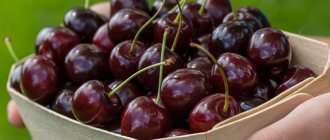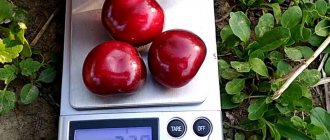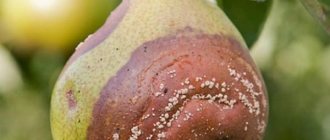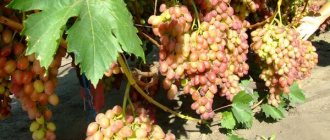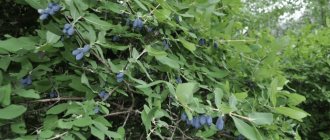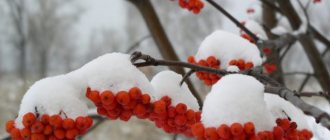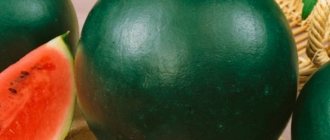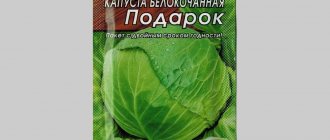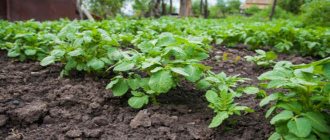Cherry Lyubskaya: variety description, photos, reviews, best pollinators
Unfortunately, many fruit trees grown in garden plots are self-fertile, so without the presence of pollinators nearby, their harvest will be too small. But if several apple and pear trees are planted in the gardens, then even two or three cherry trees are too many for most summer residents.
That is why those varieties of this fruit crop that are self-pollinating are so valued. These include Lyubskaya cherry
, which, without the presence of pollinating cherries nearby, is capable of producing an excellent harvest every year.
Other characteristics of the Lyubskaya cherry variety, advantages, nuances of planting and growing, and much more will be discussed below.
The content of the article:
1. History of the variety 2. Characteristics and description of the variety 3. Pollinator trees for the Lyubskaya cherry 4. Productivity of the cherry variety 5. Diseases and pests 6. Advantages and disadvantages 7. Planting and cultivation 8. Further care 9. Pruning the Lyubskaya cherry 10. Reviews about the Lyubskaya cherry
How and when to plant
It is advisable to soak the purchased seedling in warm water for a day. This will provide additional stimulation to the root system and will also allow the plant to harden. You can add a solution of growth stimulants to the water, or you can do without them. As a rule, seedlings are purchased in early spring; for this variety, autumn planting is more traumatic.
Landing algorithm:
- The selection of a suitable location is carried out according to the principle of maximum illumination.
- Cherry does not grow well in lowlands, so it is advisable to choose a slight elevation for planting . As a last resort, you can use a drainage layer that does not allow moisture to accumulate at the roots.
- Cherries of this variety love fertile soil with a neutral composition, so preparation must be done in advance.
- Planting is carried out according to the standard scheme; it is necessary to use a wooden support - a peg - to form an even and beautiful trunk.
- After planting, it is necessary to water the soil well at the roots and, if necessary, mulch it to prevent weed growth and drying out.
Video shows how to plant cherries:
In order for the seedling to have more strength for the subsequent harvest, it is necessary to cut off all flowering buds or ovaries. This will save energy for further growth and development of the root system. Further care is not particularly difficult. Usually this means watering and loosening, because fertilizing is not recommended in the first year after planting. The secrets of subsequent cultivation and care of this non-capricious plant are described below. But here’s how to plant common youth cherries, and how big the fruits of this tree are.
But how to spray cherries against aphids, and which remedy is the most effective, is indicated in this article.
Here you can read reviews about the Mayak cherry in order to understand whether such a fruit tree is worth planting or not.It is also worth reading the description of the Morozova dessert cherry, and also learn more about the features of this tree: //gidfermer.com/sadovodstvo/yagody/vishnya-desertnaya-morozovoj-opisanie-sorta.html
It is also worth learning more about the existing pollinators of the Kharitonovskaya cherry.
History of the variety
Lyubskaya cherry has been grown in Russia for centuries. The exact history of the selection of this variety is unknown, but experts say that this fruit tree was grown in the Kursk region back in the 19th century. Apparently, even at that time, local gardeners crossed local cherries, and as a result of folk selection, this self-pollinating, high-yielding variety was obtained.
Photo of Lyubskaya cherry
From this area, Lyubskaya cherry gradually spread to other areas of central Russia; specialists from the Moscow Federal State Budgetary Institution VSTISP became interested in it and submitted an application for inclusion of the variety in the State Register, where it was accepted in 1947.
For the first time, a complete description of this fruit tree was given by the scientist N.I. Kichunov, a contemporary of Michurin.
Interesting!
The introduction of a fruit tree variety of folk selection, which is recommended for cultivation only in certain regions of Russia, is a rare case. Typically, such varieties have been grown in the country for decades and centuries, but they are not included in the State Register.
This cherry variety “behaves” differently in different regions, as it has a tendency to randomly mutate. Sometimes, even in neighboring garden plots, Lyubsky cherries grow with different yields, sizes and tastes of ripe berries. Therefore, in articles you can often find the name of a variety with the following additions: productive, bouquet, etc.
Reviews
Lyudmila, Smolensk Lyubskaya cherries have been growing here for a long time, the berries are sour, but are great for jam.
Valentina, Moscow region I love this cherry, the compact bush is easy to care for, trim and harvest. Yes, the berries are a little sour, but we even like it. And the compotes and jam they make are wonderful; I also dry the berries for the winter and freeze them.
Alexander, Kursk I took a seedling from my neighbors, the cherry tree took root quickly. Every year I harvest more and more. The tree is now five years old and has collected 15 kg of berries. It’s true that the birds are annoying, no amount of glitter can stop them, only the net can save them.
Lyubskaya cherry is unpretentious and productive, but due to its low winter hardiness it requires shelter for the winter in the Middle Zone and is absolutely not suitable for growing in the Northern regions.
Lyubskaya cherry: characteristics and description of the variety
Most often in gardens, cherries of this variety are grown as a shrub, although this fruit tree is included in the State Register as an ordinary one, not a steppe one.
In regions with cold, frosty winters, it is specially cut to a low size so that Lyubskaya can better withstand the cold. In the southern regions, this variety grows well on trunks.
Brief overview of Lyubskaya cherries - video
Under favorable weather conditions, the branches grow 35-40 cm annually, and in the next season, berries appear on them. After the harvest is harvested, these shoots gradually become bare, and later fruiting occurs on the peripheral branches.
Cherry Lyubskaya
– small in size, can reach no more than 2.5 m in height. The central trunk is brown with a gray tint, the bark is covered with cracks. The shoots extend from the trunk at an angle of 45 degrees, the crown is sparsely weeping.
The buds are oval in shape, extend slightly from the shoot, the foliage is pointed at the base and at the ends, their color is dark emerald. The buds are collected in bouquet inflorescences, each of which contains up to 4 flowers, their legs are about 3 cm long, the color of the petals is boiling white.
The fruits of the Lyubskaya cherry are uneven in size, medium or large in size, weighing 4.5-5 g.
The shape of the berries is round, the top is blunt, the color of the berries is dark red, the abdominal seam is clearly visible, with a clearly visible light stripe running along it. The pulp is bright red, juicy, with a slight sourness.
The stone is also round, small in size, its tip is sharp, easily separated from the pulp in ripe fruits, the percentage of the stone mass to the size of the fruit is about 8%. The berries are tightly attached to the stalks; even ripe fruits are not prone to shedding.
The taste of ripe Lyubskaya cherry berries is mediocre; the variety has low resistance to fungal diseases.
However, it is the Lyubskaya cherry that can be found in all regions of Russia, where it can withstand frost. This is primarily due to the fact that this variety is highly self-fertile.
Photo of a diseased cherry
Important!
The harvested Lyubskaya cherry harvest is technical in purpose, since the berries are too sour. However, it is noted that in the southern regions the percentage of ascorbic acid in the berries of this cherry is less than in trees growing in the central zone of the country.
Ripe fruits are used to make compotes and jam. Many summer residents make wine from Lyubskaya cherry berries.
CHERRY!
• Cherry Shokoladnitsa: description and features of growing the variety
This fruit tree's resistance to drought is average, so if there is little rainfall in the summer, it definitely requires watering.
Although resistance to frost is high, it is difficult to grow this variety in the northern regions - it often freezes out.
In the middle zone and regions with similar climatic conditions, the life expectancy of the Lyubsk cherry is short - no more than 13-15 years. In the central and southern regions this period increases to 23-24 years. The thing is that in colder climates in winter, trunks or branches often freeze out, and with age, cherries find it more difficult to “come to their senses” during the summer.
Interesting!
The buds of this cherry variety tolerate severe frosts much better than the wood of the trunk and branches.
Harvesting and storage
The harvest must be harvested in one go so that the remaining berries on the tree do not attract birds. If the berries will be transported, they must be removed from the tree with the petioles.
Attention! Fruits collected without petioles must be processed within 24 hours.
Collected cherries should be stored at a temperature of 0 to −1 ° C, air humidity should be about 85%. In such conditions, the harvest can last about 10 days.
For longer storage, the berries can be frozen; they will not lose their taste and benefits.
Pollinator trees for Lyubskaya cherry
The buds on the Lyubskaya cherry blossom in the last ten days of May, flowering continues for about a week. Fruiting is abundant and consistent, depending on the climatic conditions of the growing region - from the last ten days of July to the second ten days of August. This variety is highly self-pollinating; up to 50% of flowers bear fruit.
Many experienced gardeners and experts say that if other varieties with the same flowering period are planted next to this cherry, then the Lyubskaya yield will be close to 100%.
The best pollinator varieties for this Lyubskaya cherry fruit tree:
- Vladimirka;
- Zhukovskaya;
- Anadolskaya;
- Spanking is early;
- Lotovaya;
- Fertile Michurina.
Productivity of cherry variety Lyubskaya
Seedlings of this variety begin to bear fruit within a couple of years after planting, the yield increases quickly - within a few seasons after the first harvest, the productivity becomes close to the maximum result.
Since this fruit tree is prone to mutation, its productivity directly depends on compliance with the rules of care and growing location.
On average, from 10 to 25 kg of ripe fruits are harvested from one tree of the Lyubskaya variety; the maximum harvested harvest from mature cherries is known to be up to 50-52 kg.
Need to know!
With proper care: protection from diseases and pests, timely fertilizing, cherry yields increase significantly.
CHOOSE RASPBERRY!
• Raspberry tree Skazka • Indian Summer raspberries • Diamond raspberries • Eurasia variety
Diseases and pests
Lyubskaya cherry has low resistance to fungal diseases, in particular to coccomycosis. Therefore, for preventive purposes, it is recommended in the spring before the sap begins to flow and in the fall after all the foliage has fallen, to treat the tree with special preparations.
The main pests that can attack cherries are aphids and cherry sawflies. They can be combated by treating trees with insecticide solutions, or using effective folk remedies.
Cherry pests - video
Care
Watering
In normal summer weather conditions, it is recommended to water cherries 3 times per season. The first time - immediately after flowering, simultaneously with the application of fertilizer, the second - when the berries begin to grow, the third time - in preparation for winter in early October. The first two times you need to spend 30–60 liters per plant, water-recharging watering (autumn) will require 60–80 liters. Of course, in dry weather or, conversely, heavy rains, the watering scheme is adjusted.
Top dressing
Fertilizer application is necessary from the 3rd year of life, since in the first 2 years the plant will have enough of the mineral and organic substances that were added to the ground during planting.
Table: scheme for applying fertilizers and pollinators for cherries
| Time | Fertilizers and their quantity |
| In early spring | Nitrogen fertilizers 50–70 g |
| When the cherry blossoms fade, the next one is the same after 12–15 days |
|
| In the fall when digging |
|
Video: subtleties of caring for cherries
Trimming
As with other fruit trees, pruning is an important part of cherry tree care. Despite the fact that Lyubskaya’s crown is not thickened, pruning cannot be neglected, since dry, frozen branches damaged by diseases and pests must be removed. Pruning is carried out in early spring (before sap flows in the tree), removing unnecessary parts with a sharp tool. Root shoots must also be removed.
You need to trim the cherry tree with a sharp tool.
Shelter for the winter
One of the disadvantages of the Lyubskaya cherry variety is the susceptibility of the trunk bark and branches to freezing. This factor prompts many gardeners in the northern and central parts of the country to abandon growing Lyubskaya. In order to try to avoid frost damage, it is necessary to cover the lower part of the trunk and lower branches with non-woven synthetic material, having previously tied the trunk with spruce branches. This will also protect the cherries from rodents and hares.
The shelter will save the cherry from frost and rodents
Table: disease and pest control
| Pests/diseases | How do they manifest themselves? | Prevention | Struggle |
| Coccomycosis | Red dots appear on the leaves. The affected leaves fall off, the tree weakens, and has difficulty withstanding the winter. This disease also affects the fruits - they become deformed and become inedible. |
| Treatment with Bordeaux mixture in the spring during the leaf blooming period, after the petals fall - with copper oxychloride (0.4%), after harvesting - with Bordeaux mixture. |
| Moniliosis | Gray growths appear on the bark and fruits. The cherries rot and fall off. Branches and leaves affected by moniliosis look burnt. |
| |
| Cherry aphid | Aphids suck sap from plants, which leads to drying of leaves and deformation of shoots. |
| |
| Weevil | The insect attacks buds, flowers, and ovaries. The larvae eat away the kernels near the seeds. |
|
Photo: cherry diseases and pests
Weevil affects buds, flowers, ovaries
With moniliosis, the cherry looks burnt
Coccomycosis is a fungal disease to which the Lyubskaya variety is susceptible.
Aphids suck sap from plants
Advantages and disadvantages
Lyubskaya cherry is one of the best technical varieties, the main advantages of which are:
- high percentage of self-fertility;
- flowering occurs at the end of May, so flowers and ovaries are not damaged by spring frosts;
- By providing these fruit trees with appropriate care, you can achieve high yields from the variety;
- the sparse crown and miniature size make it easier to care for the branches and collect ripe fruits;
- even if the care is not very good, the fruiting of the Lyubskaya cherry is still quite high;
- easy to separate the seeds from the pulp;
- the harvested crop tolerates transportation well over long distances and is stored in a cool place for a long time;
- the fruits easily move away from the stalks, but do not fall off;
- ripe fruits are quite large.
This cherry has few disadvantages:
- poor resistance to fungal diseases;
- in regions with a harsh climate, this cherry does not grow without additional shelter;
- fruits are too sour;
- The trunks of this variety often suffer from sunburn.
Lyubskaya cherry: planting and growing
Seedlings of this fruit tree should be planted only in early spring, before the buds have yet opened. Otherwise, the trees may not take root. If the seedlings were purchased in the autumn, then they are dug in and a hole is prepared for planting. And in early spring, Lyubskaya cherry seedlings are transplanted to a permanent place in the open ground.
Photos of Lyubskaya cherry seedlings
Important!
The planting site should be sunny, ideally on the west side, on a gentle slope. Groundwater should ideally be located at a level of 2 meters from the surface or deeper.
Soil acidity – neutral or slightly alkaline. In autumn, manure should be added to it at the rate of at least 5 kg per square. The best type of soil is loam.
The best neighbors for this variety will be other pollinating cherries. But taller trees that will shade the low, compact Lyubskaya should not be planted nearby.
Any stone fruit crops can be planted next to this cherry tree.
You can also plant the following trees:
- Oak trees;
- maples;
- linden;
- birch trees
Fruit bushes (raspberries, currants, sea buckthorn and others) usually grow in width, especially their root system. Therefore, it is not recommended to plant them next to fruit trees, as these crops will compete for moisture and fertilizers.
In the tree trunks of the cherry tree, you can plant some perennial herbs that will protect the soil from heat and retain moisture:
- hoof;
- periwinkle;
- tenacious;
- mint;
- budra;
- Melissa.
The planting pit for a seedling of this variety should have the following dimensions: depth up to 0.6 m, diameter - about 0.8 cm. The top layer of soil selected from the pit is mixed with humus (about 10 kg), to which 50 g of potassium is added and phosphorus fertilizer. Chalk or dolomite flour is added to acidified soil, and fine river sand is added to heavy soil.
Photo of planting pit for cherries
A stake is driven into the hole, to which the seedling will be tied after planting. The cherry is placed in the center, its root system is straightened, covered with substrate, constantly compacting it. The neck cannot be buried; it should be 6-7 cm above the soil level.
The trunk circle is ringed with a roller of soil. 20-30 liters of water are poured under each cherry tree. And then mulch the soil with humus or straw.
Landing Features
Lyubskaya cherry is a self-fertile crop. But planting pollinators nearby will increase the number of ovaries. Suitable varieties for this:
- Shpanka Early;
- Zhukovskaya;
- Vladimirskaya;
- Youth;
- Lotovaya;
- Anadolskaya;
- Fertile Michurina.
The best time to plant cherries is early autumn
Cherries are planted on flat or elevated areas where sunlight penetrates well. The tree should not be exposed to northeastern and northern winds. To prevent the plant from rotting, you need to choose a place with groundwater located at a level of 1.5 m from the surface. Cherry prefers sandy loam, loamy and sandy soils with a neutral acidity level.
Important! It is undesirable to choose low-lying areas where the tree will be exposed to cold gusts of wind.
Selection of seedlings
For planting, annual seedlings 1 m high without signs of disease are used. If there are damaged areas on the root system, they need to be trimmed back to healthy tissue. The plant should have several branches and branched roots . It is better to purchase seedlings in the fall, when there is a large selection.
The further growth of the crop depends on the choice of a healthy seedling
In order for the plant to survive until spring, it should be buried. For this:
- dig a hole 30 cm deep, make a 45° slope on one side, where the seedling is placed;
- the roots and 1/3 of the trunk are sprinkled with earth;
- then the plant is watered with two buckets of water so that the soil adheres well to the roots;
- the tree is covered with spruce branches, this will protect it from rodents;
- after snow falls, it is raked onto the trunk in a layer of 40–50 cm.
Step by step process
Lyubskaya is planted in sandy loam, loamy or sandy soil.
Cherries can be planted in spring (April) and autumn (until the first ten days of October). Since the soil settles over time, preparation of the pit begins in advance. It is important to observe the following features:
- If planting is planned in April, this is done in September-October, and for autumn planting, work is carried out 2 weeks before the procedure.
- The depth of the hole should reach 50 cm, and the diameter - 60 cm. In this case, you need to focus on the root system of the seedling; it should fit freely in the hole.
- The removed soil is mixed with 15 kg of humus, 400 g of superphosphate, 90 g of potassium chloride and 500 g of ash. A bucket of sand is also added to clay soil.
- If several trees are to be planted, the holes are placed every 2.5 m, and the rows are spaced 2 m apart.
Before you start planting, you need to inspect the roots. If they are dry, the plant is immersed in water at room temperature for 3 hours.
The cherry planting itself occurs in the following order:
- The procedure begins by installing a stake in the center of the hole. After this, the prepared nutrient mixture is poured onto the bottom in the form of a tubercle. The height of the mound should be such that the root collar of the plant, after placing it in the hole, is 3 cm above the ground.
- Then the seedling is covered with soil.
- When the hole is completely filled with soil mixture, an earthen roll is formed in a circle around the trees at a distance of 20 cm and 20–30 liters of water are poured into the resulting hole.
- The plant is tied to an established stake. The tree trunk soil is covered with mulch with a layer of 3–4 cm.
Important! During the planting process, it is necessary to ensure that the trunk of the seedling is in an upright position.
Video: practical tips for planting a cherry tree
Further care for the Lyubskaya variety
In the first season after planting, young cherries are watered regularly; after the soil dries, they must be loosened. Mature trees require less frequent soil moisture. The amount of watering increases only during the flowering period; 20-21 days before harvest, watering should be stopped. If the autumn is dry, water-charging irrigation must be carried out.
It is important to know!
Before the onset of winter, the tree trunk circle is mulched with a thick layer of humus (at least 8-10 cm thick); in cold regions, the bushes are covered with burlap, spruce branches, or other covering material is used. This shelter will protect trees from rodents.
Fertilizing
The yield of the Lyubskaya cherry variety directly depends on the quantity and quality of fertilizing applied. Experts recommend using a layer of mulch material, for example, mullein, to which wood ash is added, as fertilizer. At the same time, a sufficient amount of nitrogen, potassium and phosphorus gets into the soil.
Feeding cherries - video
Growing
To reap maximum yields in the future, choose high-quality planting material. Seedlings 70-100 cm in height, no older than two years old, take root best.
Helpful advice. It is easier to understand from a seedling with leaves whether it is healthy or not.
When you buy a seedling (it is best to do this in trusted stores or specialized nurseries), select a place for planting. This should be a site in a warm, bright place, protected from gusts of wind. The groundwater should lie deep enough; if possible, plant the crop on a hill, as it is damp in the lowlands. The acid-base composition should be neutral; sandy loam soils are considered the best. Read about the features of the Morel cherry variety here.
Now:
- Dig a hole 60 cm deep and 80 cm in diameter.
- Add ash, potassium nitrate, superphosphate, and humus to the hole.
- Place the dug top layer of soil in a heap on the bottom - about 15 cm.
- Lower the tree into the hole, straighten the roots, install a peg, and tie the seedling to it.
- Then fill the hole with fertile soil and compact it thoroughly. Spill the soil with soft water (preferably settled water), make mulch with humus or peat.
The most favorable time for planting Lyubskaya cherries is the beginning of autumn or mid-spring. Find out how to graft cherry onto cherry at this link.
Ideal neighbors of the variety are cherries, apple trees, grapes, and other cherries. It is better to plant currants further away.
Reviews from those who planted the Lyubskaya cherry variety
Some of the reviews from gardeners who grow Lyubskaya cherries in their garden plots are presented below.
Oksana, 50 years old, Voronezh:
“Several different varieties of cherries are planted on my plot, including Lyubskaya. We planted it specifically to have berries for making jam and compotes. Since other stone fruit crops grow nearby, Lyubskaya’s yield is quite high. But eating its fruits fresh is not very pleasant - they are too sour.”
Maria, 49 years old, Ryazan:
“The Lyubskaya cherry has been growing in our garden for quite a long time - at least 8 years. Its yield is quite stable, since I apply fertilizer to the tree trunk circle on time and water it in a timely manner. We also planted a couple of other cherry varieties nearby, which cross-pollinate, and at the same time the yield of all these fruit trees increases.”
Anastasia, 39 years old, Rostov:
“My mother planted Lyubskaya cherry on the plot. The variety has been growing in our country for more than 15 years, but its yield is still high. By the way, the berries are quite sweet, although according to reviews from gardeners, they thought that this variety would have too sour fruits. It turned out that in the southern regions, probably under the influence of sunlight, the fruits of this cherry contain less ascorbic acid.”
Olga, 28 years old, Ulyanovsk:
“My mother decided to update the cherry varieties in the garden, but she bought the seedlings not at the nursery, but at the market. A couple of trees turned out to be exactly the variety that the seller said, and the third seedling turned out to be a Lyubskaya cherry. They didn’t throw it away, they left it to see how it would bear fruit. As a result, after a few years they began to collect a bucket and a half of berries from the tree. Their taste, of course, turned out to be sour, but my husband began to make wine from the fruits of these cherries. It turns out to have a rather pleasant taste, since sugar is naturally added according to the technology. In general, now for all holidays we put our own wine on the table, which all guests like.”
Lyubskaya cherry is one of the oldest cherry varieties grown by Russian gardeners. The main advantage of the tree is its high self-fertility and sufficient unpretentiousness.
